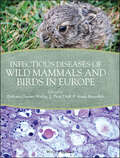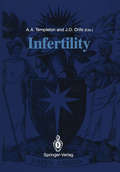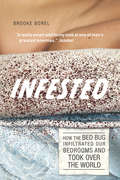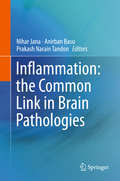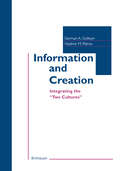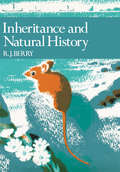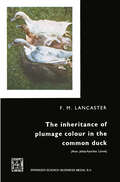- Table View
- List View
Infectious Diseases of Wild Mammals
by Elizabeth S. Williams Ian K. BarkerInfectious Diseases of Wild Mammals, Third Edition presents the latest information on the diagnosis and treatment of infectious disease in both free-ranging and captive wild mammals. Editors Elizabeth Williams and Ian Barker have recruited 71 contributors, all noted experts in their fields, to update this new edition. This reference provides valuable information on each disease, including Etiology History Distribution Epidemiology Clinical signs Pathology Immunity Diagnosis Treatment Control This latest edition is a leading reference book for Wildlife biologists, managers, and rehabilitators Biology students Conservationists Public health workers
Infectious Diseases of Wild Mammals and Birds in Europe
by Dolores Gavier-Widén J. Paul Duff Anna MeredithInfectious Diseases of Wild Mammals and Birds in Europe is a key resource on the diagnosis and treatment of infectious diseases in European wildlife that covers the distinctive nature of diseases as they occur in Europe, including strains, insect vectors, reservoir species, and climate, as well as geographical distribution of the diseases and European regulations for reporting, diagnosis and control. Divided into sections on viral infections, bacterial infections, fungal and yeast infections, and prion infections, this definitive reference provides valuable information on disease classification and properties, causative agents, epidemiology, pathogenesis, and implications for human, domestic and wild animal health. Key features: • Brings together extensive research from many different disciplines into one integrated and highly useful definitive reference. • Zoonotic risks to human health, as well as risks to pets and livestock are highlighted. • Each disease is covered separately with practical information on the animal species in which the disease has been recorded, clinical signs of the disease, diagnostic methods, and recommended treatments and vaccination. • Wildlife vaccination and disease surveillance techniques are described. • Examines factors important in the spread of disease such as changing climate, the movement of animals through trade, and relaxations in the control of wide animal populations.
Infectious Diseases of Wild Mammals and Birds in Europe
by Dolores Gavier-Widen Anna Meredith J. Paul Duff Dolorés Gavier-WidenInfectious Diseases of Wild Mammals and Birds in Europe is a key resource on the diagnosis and treatment of infectious diseases in European wildlife that covers the distinctive nature of diseases as they occur in Europe, including strains, insect vectors, reservoir species, and climate, as well as geographical distribution of the diseases and European regulations for reporting, diagnosis and control. Divided into sections on viral infections, bacterial infections, fungal and yeast infections, and prion infections, this definitive reference provides valuable information on disease classification and properties, causative agents, epidemiology, pathogenesis, and implications for human, domestic and wild animal health. Key features: • Brings together extensive research from many different disciplines into one integrated and highly useful definitive reference. • Zoonotic risks to human health, as well as risks to pets and livestock are highlighted. • Each disease is covered separately with practical information on the animal species in which the disease has been recorded, clinical signs of the disease, diagnostic methods, and recommended treatments and vaccination. • Wildlife vaccination and disease surveillance techniques are described. • Examines factors important in the spread of disease such as changing climate, the movement of animals through trade, and relaxations in the control of wide animal populations.
Infectious Tropical Diseases and One Health in Latin America (Parasitology Research Monographs #16)
by Heinz Mehlhorn Jorg HeukelbachThis book covers current aspects of important infectious diseases affecting human and animal health in Latin American countries. Readers are equipped with details on arthropod vectors as well as on neglected health problems. Diseases covered include Neglected Tropical Diseases such as Chagas Disease, schistosomiasis, tungiasis, myiasis and leishmaniasis, but also Zika and Chikungunya viral infections, plague and yellow fever. One focus is given on parasitic transmission routes.In addition, the authors describe current therapeutic options and sustainable control measures, considering both human and animal health. By highlighting options within the interdisciplinary One Health approach, they round off this work into a cutting-edge reference for diverse expert readers. Scientists and clinicians concerned on public health, entomology, tropical medicine and parasitology not only in Latin America will find this collection particularly valuable.Finally, these contributions are essential in the framework of the Sustainable Development Goals and the targets of SDG 3 (Good Health and Well-being) in order to combat and end epidemics of Neglected Tropical Diseases.
Infektionskrankheiten der Katze
by Katrin Hartmann Julie K. LevyDer erste in Deutsch erschienene Band aus der Reihe Veterinary Self-Assessment Colour Review behandelt alle Arten der Infektionskrankheiten der Katze. Er umfaßt Infektionen, die von Viren, Bakterien, Parasiten und Pilzen verursacht werden. Die 199 klinischen Fälle werden wie in der Praxis nach dem Zufallsprinzip präsentiert. Die breite Auswahl der Fälle sorgt dafür, daß alle Organsysteme der Katze vorkommen, die von Infektionen befallen werden. Die illustrierten klinischen Fallbeispiele enthalten in den Text integrierte Fragen und ausführlich erklärte Antworten. Das Buch wendet sich an Ärzte in Praxis und Klinik, an Studenten, HelferInnen und Techniker.
Infektionskrankheiten der Katze
by Katrin Hartmann Julie K. LevyDer erste in Deutsch erschienene Band aus der Reihe Veterinary Self-Assessment Colour Review behandelt alle Arten der Infektionskrankheiten der Katze. Er umfaßt Infektionen, die von Viren, Bakterien, Parasiten und Pilzen verursacht werden. Die 199 klinischen Fälle werden wie in der Praxis nach dem Zufallsprinzip präsentiert. Die breite Auswahl der Fälle sorgt dafür, daß alle Organsysteme der Katze vorkommen, die von Infektionen befallen werden. Die illustrierten klinischen Fallbeispiele enthalten in den Text integrierte Fragen und ausführlich erklärte Antworten. Das Buch wendet sich an Ärzte in Praxis und Klinik, an Studenten, HelferInnen und Techniker.
The Inferior Colliculus
by Jeffery A. Winer Christoph E. SchreinerConnecting the auditory brain stem to sensory, motor, and limbic systems, the inferior colliculus is a critical midbrain station for auditory processing. Winer and Schreiner's The Inferior Colliculus, a critical, comprehensive reference, presents the current knowledge of the inferior colliculus from a variety of perspectives, including anatomical, physiological, developmental, neurochemical, biophysical, neuroethological and clinical vantage points. Written by leading researchers in the field, the book is an ideal introduction to the inferior colliculus and central auditory processing for clinicians, otolaryngologists, graduate and postgraduate research workers in the auditory and other sensory-motor systems.
The Inferior Oilvary Complex (Advances in Anatomy, Embryology and Cell Biology #155)
by Anastasia Bozhilova-Pastirova Wladimir A. OvtscharoffAlthough many studies have established the connections of the inferior olivary complex, there have been relatively few studies on the morphology of this nuclear complex. On the base of the similar topographic relations and connections with the cerebellum, the inferior olivary complex is regarded as homologous in all vertebrates. We present comprehensive light microscopical qualitative and quantitative analysis of the inferior olivary complex of different representatives of submammalian and mammalian vertebrates, including human. A detailed comparison was made at the structural level. Cytoarchitecture and cellular morphology of the inferior olivary complex have been studied in several submammalian (carp, frog, lizard, tortoise, pigeon) and mammalian species (rat, cat, and for the first time ground squirrel Citellus citellus L), including human.
Infertility
by Allan A. Templeton James O. DrifeInfertility, as with many aspects of medicine, is at the mercy of rapid technological advance. Many of these developments initially seem attractive to both clinicians and patients, but need to be rigorously assessed if their real value is to be understood and clinical practice is to develop. In this book issues of importance to the management of infertile patients are discussed. The gaps in our knowledge which prevent a better understanding of the condition are identified, and recent developments, both clinical and scientific, are subjected to peer review and discussion. An important feature of the book is an acceptance that training in infertility practice is a real problem. This is perceived not only by the practising clinicians, both doctors and nurses, but particularly by the clinical scientists, including embryologists, who now provide such an essential part of the service. Similarly the provision of the clinical service has been examined in detail from a variety of standpoints, in an attempt to make sensible recommendations which balance real need with limited resource. The book is based on the papers presented and discussed at the 25th RCOG Study Group held in April 1992. The discussion after each paper was civilised but uncompromising and forms an important part of this publication. The rapid processing of the written and recorded material by the staff at the RCOG, and particularly Miss Sally Barber, has ensured that the book has been produced while the issues are live, the reviews contemporary and the discussion relevant.
Infested: How the Bed Bug Infiltrated Our Bedrooms and Took Over the World
by Brooke BorelBed bugs. Few words strike such fear in the minds of travelers. In cities around the world, lurking beneath the plush blankets of otherwise pristine-looking hotel beds are tiny bloodthirsty beasts just waiting for weary wanderers to surrender to a vulnerable slumber. Though bed bugs today have infested the globe, the common bed bug is not a new pest at all. Indeed, as Brooke Borel reveals in this unusual history, this most-reviled species may date back over 250,000 years, wreaking havoc on our collective psyche while even inspiring art, literature, and music—in addition to vexatious red welts. In Infested, Borel introduces readers to the biological and cultural histories of these amazingly adaptive insects, and the myriad ways in which humans have responded to them. She travels to meet with scientists who are rearing bed bug colonies—even by feeding them with their own blood (ouch!)—and to the stages of musicals performed in honor of the pests. She explores the history of bed bugs and their apparent disappearance in the 1950s after the introduction of DDT, charting how current infestations have flourished in direct response to human chemical use as well as the ease of global travel. She also introduces us to the economics of bed bug infestations, from hotels to homes to office buildings, and the expansive industry that has arisen to combat them. Hiding during the day in the nooks and seams of mattresses, box springs, bed frames, headboards, dresser tables, wallpaper, or any clutter around a bed, bed bugs are thriving and eager for their next victim. By providing fascinating details on bed bug science and behavior as well as a captivating look into the lives of those devoted to researching or eradicating them, Infested is sure to inspire at least a nibble of respect for these tenacious creatures—while also ensuring that you will peek beneath the sheets with prickly apprehension.
Infested: How the Bed Bug Infiltrated Our Bedrooms and Took Over the World
by Brooke BorelBed bugs. Few words strike such fear in the minds of travelers. In cities around the world, lurking beneath the plush blankets of otherwise pristine-looking hotel beds are tiny bloodthirsty beasts just waiting for weary wanderers to surrender to a vulnerable slumber. Though bed bugs today have infested the globe, the common bed bug is not a new pest at all. Indeed, as Brooke Borel reveals in this unusual history, this most-reviled species may date back over 250,000 years, wreaking havoc on our collective psyche while even inspiring art, literature, and music—in addition to vexatious red welts. In Infested, Borel introduces readers to the biological and cultural histories of these amazingly adaptive insects, and the myriad ways in which humans have responded to them. She travels to meet with scientists who are rearing bed bug colonies—even by feeding them with their own blood (ouch!)—and to the stages of musicals performed in honor of the pests. She explores the history of bed bugs and their apparent disappearance in the 1950s after the introduction of DDT, charting how current infestations have flourished in direct response to human chemical use as well as the ease of global travel. She also introduces us to the economics of bed bug infestations, from hotels to homes to office buildings, and the expansive industry that has arisen to combat them. Hiding during the day in the nooks and seams of mattresses, box springs, bed frames, headboards, dresser tables, wallpaper, or any clutter around a bed, bed bugs are thriving and eager for their next victim. By providing fascinating details on bed bug science and behavior as well as a captivating look into the lives of those devoted to researching or eradicating them, Infested is sure to inspire at least a nibble of respect for these tenacious creatures—while also ensuring that you will peek beneath the sheets with prickly apprehension.
Infested: How the Bed Bug Infiltrated Our Bedrooms and Took Over the World
by Brooke BorelBed bugs. Few words strike such fear in the minds of travelers. In cities around the world, lurking beneath the plush blankets of otherwise pristine-looking hotel beds are tiny bloodthirsty beasts just waiting for weary wanderers to surrender to a vulnerable slumber. Though bed bugs today have infested the globe, the common bed bug is not a new pest at all. Indeed, as Brooke Borel reveals in this unusual history, this most-reviled species may date back over 250,000 years, wreaking havoc on our collective psyche while even inspiring art, literature, and music—in addition to vexatious red welts. In Infested, Borel introduces readers to the biological and cultural histories of these amazingly adaptive insects, and the myriad ways in which humans have responded to them. She travels to meet with scientists who are rearing bed bug colonies—even by feeding them with their own blood (ouch!)—and to the stages of musicals performed in honor of the pests. She explores the history of bed bugs and their apparent disappearance in the 1950s after the introduction of DDT, charting how current infestations have flourished in direct response to human chemical use as well as the ease of global travel. She also introduces us to the economics of bed bug infestations, from hotels to homes to office buildings, and the expansive industry that has arisen to combat them. Hiding during the day in the nooks and seams of mattresses, box springs, bed frames, headboards, dresser tables, wallpaper, or any clutter around a bed, bed bugs are thriving and eager for their next victim. By providing fascinating details on bed bug science and behavior as well as a captivating look into the lives of those devoted to researching or eradicating them, Infested is sure to inspire at least a nibble of respect for these tenacious creatures—while also ensuring that you will peek beneath the sheets with prickly apprehension.
Infested: How the Bed Bug Infiltrated Our Bedrooms and Took Over the World
by Brooke BorelBed bugs. Few words strike such fear in the minds of travelers. In cities around the world, lurking beneath the plush blankets of otherwise pristine-looking hotel beds are tiny bloodthirsty beasts just waiting for weary wanderers to surrender to a vulnerable slumber. Though bed bugs today have infested the globe, the common bed bug is not a new pest at all. Indeed, as Brooke Borel reveals in this unusual history, this most-reviled species may date back over 250,000 years, wreaking havoc on our collective psyche while even inspiring art, literature, and music—in addition to vexatious red welts. In Infested, Borel introduces readers to the biological and cultural histories of these amazingly adaptive insects, and the myriad ways in which humans have responded to them. She travels to meet with scientists who are rearing bed bug colonies—even by feeding them with their own blood (ouch!)—and to the stages of musicals performed in honor of the pests. She explores the history of bed bugs and their apparent disappearance in the 1950s after the introduction of DDT, charting how current infestations have flourished in direct response to human chemical use as well as the ease of global travel. She also introduces us to the economics of bed bug infestations, from hotels to homes to office buildings, and the expansive industry that has arisen to combat them. Hiding during the day in the nooks and seams of mattresses, box springs, bed frames, headboards, dresser tables, wallpaper, or any clutter around a bed, bed bugs are thriving and eager for their next victim. By providing fascinating details on bed bug science and behavior as well as a captivating look into the lives of those devoted to researching or eradicating them, Infested is sure to inspire at least a nibble of respect for these tenacious creatures—while also ensuring that you will peek beneath the sheets with prickly apprehension.
Infested: How the Bed Bug Infiltrated Our Bedrooms and Took Over the World
by Brooke BorelBed bugs. Few words strike such fear in the minds of travelers. In cities around the world, lurking beneath the plush blankets of otherwise pristine-looking hotel beds are tiny bloodthirsty beasts just waiting for weary wanderers to surrender to a vulnerable slumber. Though bed bugs today have infested the globe, the common bed bug is not a new pest at all. Indeed, as Brooke Borel reveals in this unusual history, this most-reviled species may date back over 250,000 years, wreaking havoc on our collective psyche while even inspiring art, literature, and music—in addition to vexatious red welts. In Infested, Borel introduces readers to the biological and cultural histories of these amazingly adaptive insects, and the myriad ways in which humans have responded to them. She travels to meet with scientists who are rearing bed bug colonies—even by feeding them with their own blood (ouch!)—and to the stages of musicals performed in honor of the pests. She explores the history of bed bugs and their apparent disappearance in the 1950s after the introduction of DDT, charting how current infestations have flourished in direct response to human chemical use as well as the ease of global travel. She also introduces us to the economics of bed bug infestations, from hotels to homes to office buildings, and the expansive industry that has arisen to combat them. Hiding during the day in the nooks and seams of mattresses, box springs, bed frames, headboards, dresser tables, wallpaper, or any clutter around a bed, bed bugs are thriving and eager for their next victim. By providing fascinating details on bed bug science and behavior as well as a captivating look into the lives of those devoted to researching or eradicating them, Infested is sure to inspire at least a nibble of respect for these tenacious creatures—while also ensuring that you will peek beneath the sheets with prickly apprehension.
Infested: How the Bed Bug Infiltrated Our Bedrooms and Took Over the World
by Brooke BorelBed bugs. Few words strike such fear in the minds of travelers. In cities around the world, lurking beneath the plush blankets of otherwise pristine-looking hotel beds are tiny bloodthirsty beasts just waiting for weary wanderers to surrender to a vulnerable slumber. Though bed bugs today have infested the globe, the common bed bug is not a new pest at all. Indeed, as Brooke Borel reveals in this unusual history, this most-reviled species may date back over 250,000 years, wreaking havoc on our collective psyche while even inspiring art, literature, and music—in addition to vexatious red welts. In Infested, Borel introduces readers to the biological and cultural histories of these amazingly adaptive insects, and the myriad ways in which humans have responded to them. She travels to meet with scientists who are rearing bed bug colonies—even by feeding them with their own blood (ouch!)—and to the stages of musicals performed in honor of the pests. She explores the history of bed bugs and their apparent disappearance in the 1950s after the introduction of DDT, charting how current infestations have flourished in direct response to human chemical use as well as the ease of global travel. She also introduces us to the economics of bed bug infestations, from hotels to homes to office buildings, and the expansive industry that has arisen to combat them. Hiding during the day in the nooks and seams of mattresses, box springs, bed frames, headboards, dresser tables, wallpaper, or any clutter around a bed, bed bugs are thriving and eager for their next victim. By providing fascinating details on bed bug science and behavior as well as a captivating look into the lives of those devoted to researching or eradicating them, Infested is sure to inspire at least a nibble of respect for these tenacious creatures—while also ensuring that you will peek beneath the sheets with prickly apprehension.
Inflammation: the Common Link in Brain Pathologies
by Nihar Jana Anirban Basu Prakash Narain TandonThis unifying theme of this book-with sections on mechanisms of defense and neuropathogenesis, neurological diseases, infections of the nervous system, neuropharmacology, and novel therapies-is interactions of the immune and nervous systems. It also discusses the role of inflammation as a key mediator of different brain disorders. There have been significant scientific advances in the multidisciplinary field of neuroimmunology / neuroinflammation in the past decade, and this book, edited under the guidance of Professor P. N. Tandon, fosters communication between those who share an interest in this exciting area, including neuroscientists, immunologists, cell biologists, clinicians and neuropharmacologists.
Influence of the Host on Tumor Development (Cancer Growth and Progression #4)
by Ronald B. HerbermanIt is widely recognized that the host response to tumor munotherapy of experimental metastases in animal systems progression is an important determinant in cancer growth which are beginning to be developed for ultimate clinical and progression. Indeed, as indicated in Volume I of this trials of human cancer metastasis. series, the process of cancer growth and progression, leading This volume explores a variety of host properties that to tumor invasion and metastasis, is dependent upon the influence tumor development including dormancy, regress complex, dynamic interactions between the properties of the ion, and recurrence. In addition, current knowledge of the tumor as well as the properties of the host. While Volume III response of the central nervous system to cancer, cardiac of this series reviews in great detail the influence of tumor and pulmonary complications, dermatologic effects and development on the host, this volume emphasizes the in hematologic complications of malignancies is presented. fluence of the host on tumor development. These host re The endocrine and metabolic function of cancer patients, as sponses include host anti-tumor immune reactivity, tumor well as the production of hormones by tumors is also review dormancy, cachexia, multiple endocrine and paraneoplastic ed.
Influence of Tumor Development on the Host (Cancer Growth and Progression #3)
by Lance A. LiottaRecent experimental evidence has made it increasingly clear In particular, this volume reviews the discrete steps involved that the properties of invasive, malignant cells during tumor in metastatic invasion: the interaction of invasive tumor cells development substantially impact on the host. This is under with extracellular matrices, the basement membrane, attach scored by a variety of biochemical properties of tumor cells ment to extracellular matrices, local proteolytic degradation during their differentiation and metastatic dissemination. of matrices, and the locomotion of invasive tumor cells These properties can be analyzed at different stages of tumor through such areas of localized degradation. The critical growth and progression and this volume explores the role of the cell surface in secondary tumor formation is characteristics of primary tumors as well as the shared reviewed as are important advances in the molecular biology characteristics of both primary and secondary tumors. of metastasis initiation and maintenance. Recent advances The primary tumor comes into existence following in the role of DNA methylation in the generation of tumor preneoplastic biochemical and cellular events that ultimate cell heterogeneity and tumor progression are also critically ly result in malignant transformation. Various aspects of summarized. Chapters in this volume also review molecular metabolism, predetermined by nutritional status, often play aspects of metastatic progression, and the use of the tech a basic role. Obesity, for example, is cancer-promoting. Cell nologies of DNA transfection and somatic cell fusion in the surface carbohydrates, cytoskeletal proteins, glycoproteins, exploration of molecular aspects of metastatic progression.
Influenza and Respiratory Care (Advances in Experimental Medicine and Biology #968)
by Mieczyslaw PokorskiRespiratory infections constitute a major public health concern. The goal of this book is to share knowledge on the best advances in influenza and influenza-like viral infections, and new molecular-based diagnostic methods that discern the antigenic shift enabling viruses to constantly evolve and elude the host immune response. Co-infections, co-morbidities, persistently meager anti-flu vaccination coverage, and infection complications are dealt with. The chapters also further insight into such topics as the effects of sex hormones, and socioeconomic and anthropometric measures on respiratory and immune functions underlying the severity of asthma and respiratory allergy. Psychological functioning in respiratory disorders, taking into account quality of life, illness acceptance, and depressive symptoms is also reviewed as it is all too often underestimated by healthcare providers. The book is intended for clinicians, researchers, students, and all other actors in health-related issues.
The Influenza Viruses (The Viruses)
by Robert M. KrugInfluenza virus is an important human pathogen, frequently causing widespread disease and a significant loss of life. Much has been learned about the structure of the virus, its genetic variation, its mode of gene expression and replication, and its interaction with the host immu nologic system. This knowledge has the potential of leading to ap proaches for the control of influenza virus. In addition, research on influ enza virus has led to important advances in eukaryotic molecular and cellular biology and in immunology. A major focus of this book is the molecular biology of influenza virus. The first chapter, which serves as an introduction, describes the structure of each of the genomic RNA segments and their encoded pro teins. The second chapter discusses the molecular mechanisms involved in the expression and replication of the viral genome. In addition to other subjects, this chapter deals with one of the most distinctive features of influenza virus, namely the unique mechanism whereby viral messenger RNA synthesis is initiated by primers deaved from newly synthesized host-cell RNAs in the nudeus. Among the most significant accomplish ments in influenza virus research has been the delineation of the three dimensional structure of the two surface glycoproteins of the virus, the hemagglutinin and neuraminidase. This has provided a structural basis for mapping both the antigenic sites and the regions involved in the major biological functions of these two molecules.
Information and Creation: Integrating the “Two Cultures”
by German Golitsyn Vladimir PetrovThis book is devoted to one of the central problems of contemporary thinking, for which c.P. Snow in 1959 coined the phrase of the «Two Cultures». In this concept, human endeavour is directed on one side to the (forward-looking) sci ences (mathematics, physics, chemistry, biology, etc.) and on the other side to the (backward-looking) humanities (including psychology, linguistics, sociology, etc.). In this dichotomy Snow saw no possibility of unification. On the other hand the urge towards self-consistency and harmony in the mental and spiritual lives of both man and society as a whole is clearly one of the major forces of creativity, both scientific and artistic. This force aims at the unification of the «Two Cultures» in order to build an integrated self-consistent system for our intellectual life. Some attempts in this direction have been made before, and will be described in this book. It is our aim to contribute to the achievement of an integrated mental life on the basis of information theory. In order to construct our model, we examine the laws of information theory, leading us to the deduction of the main laws inherent in both «cultures». Thus, we consider the evolution of both non-living and living matter, human behaviour, the phenomenon of language, the sphere of aesthetics, etc. We hope that our work will be useful both for researchers (who are trying to derive different integral theories) and for various other «consumers» of scientific knowledge (meaning broad circles of intellectuals).
Information Processing in Social Insects
by Claire Detrain Jean L. Deneubourg Jacques M. PasteelsClaire Detrain, Jean-Louis Deneubourg and Jacques Pasteels Studies on insects have been pioneering in major fields of modern biology. In the 1970 s, research on pheromonal communication in insects gave birth to the dis cipline of chemical ecology and provided a scientific frame to extend this approach to other animal groups. In the 1980 s, the theory of kin selection, which was initially formulated by Hamilton to explain the rise of eusociality in insects, exploded into a field of research on its own and found applications in the under standing of community structures including vertebrate ones. In the same manner, recent studies, which decipher the collective behaviour of insect societies, might be now setting the stage for the elucidation of information processing in animals. Classically, problem solving is assumed to rely on the knowledge of a central unit which must take decisions and collect all pertinent information. However, an alternative method is extensively used in nature: problems can be collectively solved through the behaviour of individuals, which interact with each other and with the environment. The management of information, which is a major issue of animal behaviour, is interesting to study in a social life context, as it raises addi tional questions about conflict-cooperation trade-oft's. Insect societies have proven particularly open to experimental analysis: one can easily assemble or disassemble them and place them in controllable situations in the laboratory.
Information Processing in the Visual Systems of Arthropods: Symposium Held at the Department of Zoology, University of Zurich, March 6–9, 1972
by Rüdiger WehnerIt is now generally accepted for a variety of reasons - morphological as well as physiologica- that the visual systems of arthropods provide a suitable model for the study of information proces sing in neuronal networks. Unlike the neurophysiology of the visual pathway in the frog and the cat which is more than adequately documented, recent work on the compound eye and optical ganglia of spiders, crustaceans, and insects has scarcely been summarized. In order to fill this void so that others, especially vertebrate neurophysiologists may become familiar with the advan tages of these systems, our group at Zurich University organized here in March 1972, a European meeting to discuss the anatomical. ! neurophysiological and behavioral knowledge on the compound eye and the visual. pathway of arthropods. Systems analysis was regarded as the main theme of the conference, but systems analysis of a network of neurons cannot be done as a mere "black-box" maneuver. The conference therefore tried to reconcile neurophysiology and behavioral analysis in order to make predictions about a necessary and sufficient neural structure. The "wiring dia grams" of such a structure might then be confirmed histologically. Hence the aim of the conferen ce was not to deal only with the structure and function of the compound eye - i. e.
Inheritance and Natural History (Collins New Naturalist Library #61)
by R. J. BerryEver wondered why primroses have three sorts of flowers; or about pesticide resistance in rats and mice, mosquitoes and green-fly; antibiotic resistance in disease organisms – all are examples of genetical adjustment, explained in this book.

